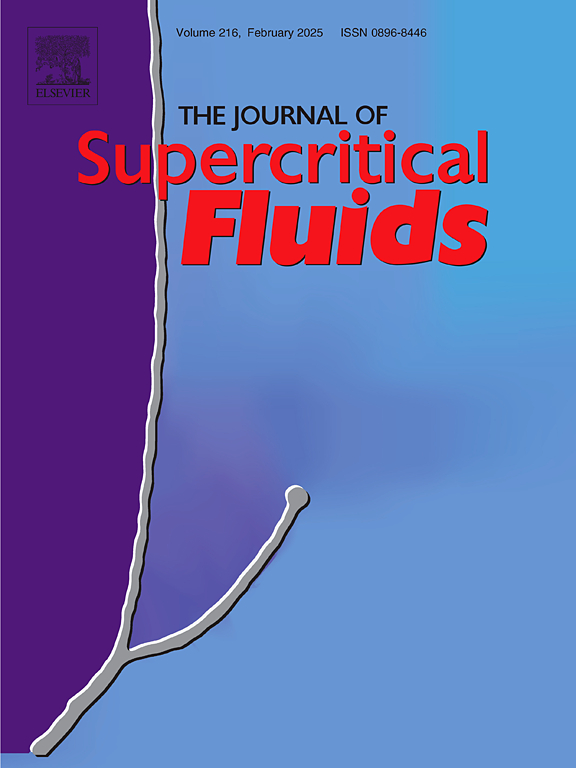Modeling of supercritical hydrogen thermodynamic properties using cubic and SAFT type equations of state
IF 3.4
3区 工程技术
Q2 CHEMISTRY, PHYSICAL
引用次数: 0
Abstract
Hydrogen, recognized as a future fuel, is considered one of the most sustainable energy sources. Accurate prediction of its thermophysical properties, particularly at high pressures, is essential for the design and development of industrial applications. Equations of state (EoSs), as practical tools for thermodynamic modeling, provide a reliable means of predicting hydrogen's thermodynamic properties. However, due to the variety of available EoSs comparing their performance in predicting the thermodynamic behavior of supercritical hydrogen can help optimize their application in real systems. This study assessed the accuracy of the PR, SRK, Quantum-corrected PR (QPR), three versions of the PρT-SAFT, and five versions of the PC-SAFT EoSs in predicting the thermodynamic properties of supercritical hydrogen under a vast range of pressures (10–2000 MPa) and temperatures (100–1000 K), including volumetric properties, caloric properties, and the Joule-Thomson effect. Additionally, the accuracy of SAFT type EoSs in reproducing hydrogen’s critical point was evaluated, revealing that the rescaled versions of PρT-SAFT EoS yield the most precise predictions of hydrogen's thermodynamic properties. Additionally, a comparison of SAFT and QPR type EoSs for predicting hydrogen's saturated thermodynamic properties shows that QPR performs best. Lastly, the ability of all eleven EoSs to accurately describe the thermodynamic properties of supercritical hydrogen in a limited range of pressures (10–100 MPa) and temperatures (100–400 K), which are more relevant to industrial applications, were investigated and compared with molecular dynamics simulation results. In these regions, the EoSs show promising results, with SRK and PρT-SAFT delivering the best performance.
用三次和SAFT型状态方程模拟超临界氢热力学性质
氢是公认的未来燃料,被认为是最可持续的能源之一。准确预测其热物理性质,特别是在高压下的热物理性质,对于工业应用的设计和开发至关重要。状态方程(EoSs)作为热力学建模的实用工具,为预测氢的热力学性质提供了可靠的手段。然而,由于可用的EoSs种类繁多,比较它们在预测超临界氢的热力学行为方面的性能有助于优化它们在实际系统中的应用。本研究评估了PR、SRK、量子校正PR (QPR)、三种版本的prk - saft和五种版本的PC-SAFT eos在大范围压力(10-2000 MPa)和温度(100-1000 K)下预测超临界氢热力学性质的准确性,包括体积性质、热性质和焦耳-汤姆逊效应。此外,评估了SAFT型EoS在再现氢临界点方面的准确性,揭示了重新缩放的prρ t -SAFT EoS可以最精确地预测氢的热力学性质。此外,比较了SAFT和QPR类型的eos预测氢的饱和热力学性质,结果表明QPR类型的eos预测效果最好。最后,研究了所有11种EoSs在与工业应用更相关的有限压力(10-100 MPa)和温度(100-400 K)范围内准确描述超临界氢热力学性质的能力,并将其与分子动力学模拟结果进行了比较。在这些地区,eos表现出了良好的效果,其中SRK和prρ t - saft表现最佳。
本文章由计算机程序翻译,如有差异,请以英文原文为准。
求助全文
约1分钟内获得全文
求助全文
来源期刊

Journal of Supercritical Fluids
工程技术-工程:化工
CiteScore
7.60
自引率
10.30%
发文量
236
审稿时长
56 days
期刊介绍:
The Journal of Supercritical Fluids is an international journal devoted to the fundamental and applied aspects of supercritical fluids and processes. Its aim is to provide a focused platform for academic and industrial researchers to report their findings and to have ready access to the advances in this rapidly growing field. Its coverage is multidisciplinary and includes both basic and applied topics.
Thermodynamics and phase equilibria, reaction kinetics and rate processes, thermal and transport properties, and all topics related to processing such as separations (extraction, fractionation, purification, chromatography) nucleation and impregnation are within the scope. Accounts of specific engineering applications such as those encountered in food, fuel, natural products, minerals, pharmaceuticals and polymer industries are included. Topics related to high pressure equipment design, analytical techniques, sensors, and process control methodologies are also within the scope of the journal.
 求助内容:
求助内容: 应助结果提醒方式:
应助结果提醒方式:


